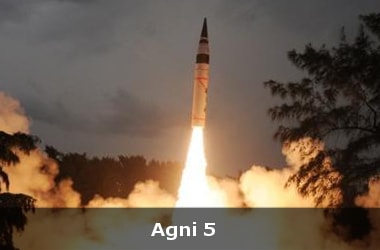
India successfully test-fired on 26
th Dec 2016 its nuclear-capable, inter-continental ballistic missile Agni 5, which has a range of over 5,000 km covering whole of China, from Abdul Kalam island off Odisha coast.
The successful test-firing will pave way for the user trial of the most potent Indian missile and its eventual induction into the special forces command (SFC).
The 3-stage, solid propellant surface-to-surface missile was test-fired from a mobile launcher from launch complex-4 of the Integrated Test Range (ITR).
About 17-metre long and weighing over 50 tonnes, the surface-to-surface missile majestically rose from the confines of its canister flawlessly and achieved all targets.
It is the 4
th developmental and 2
nd canisterised trial of the missile.
While the first test was conducted on April 19, 2012, the second was on September 15, 2013 and the third on January 31, 2015 from the same base.
More About Agni- This was the first test of the Agni-5 missile after India became a member of the Missile Technology Control Regime.
- The 17-metre long Agni-5 Missile weighs about 50 tonnes and is a very agile and modern weapon system.
- The Agni-6 is reported to be in early stages of development with a strike-range of 8,000-10,000 km.
Agni-5 is the most advanced nuclear capable missile with the following new technologies:
- Ring Laser Gyro based Inertial Navigation System (RINS) and
- Micro Navigation System (MINS)
At present, India possesses:
- Agni-1 with 700 km range,
- Agni-II with 2000 km range,
- Agni-3 and Agni-4 with with 2,500 km to more than 3,500 range